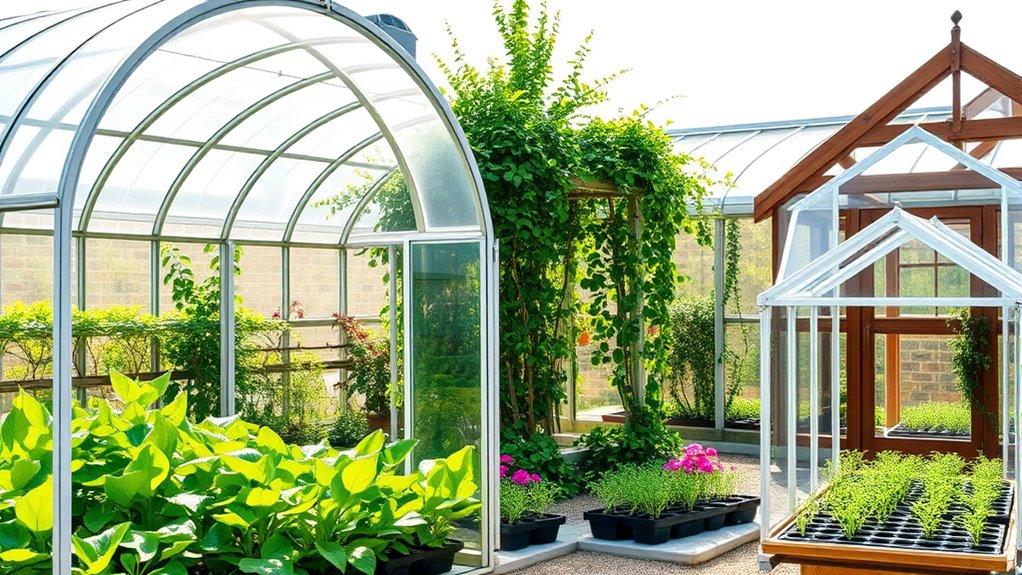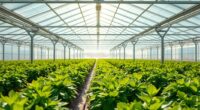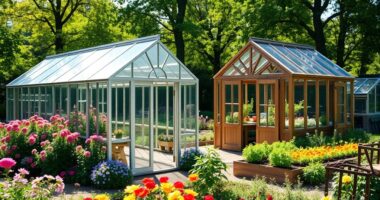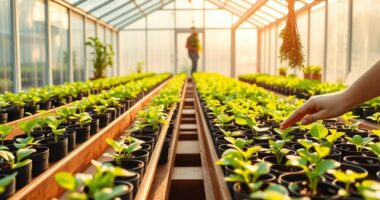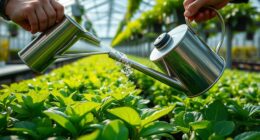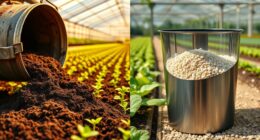Choosing the right greenhouse depends on your budget, space, climate, and gardening goals. Traditional glass greenhouses are attractive and ideal for year-round use, while polycarbonate options offer durability and good light transmission. PVC frame greenhouses are affordable and easy to assemble, perfect for beginners. Tunnel and hoop greenhouses support quick crop turnover, and portable models suit small patios or rooftops. Want a detailed guide to find your best match? Keep exploring to discover more.
Key Takeaways
- Consider your budget, space, and climate when choosing between traditional glass, polycarbonate, or PVC greenhouses.
- Determine if you need a permanent, durable structure or a portable, easy-to-assemble option.
- Match your goals: aesthetic display, year-round production, or seasonal plant starting.
- Evaluate environmental controls like ventilation, heating, and insulation features for optimal plant growth.
- Select a style that aligns with your DIY skills, maintenance capacity, and long-term gardening plans.
Traditional Glass Greenhouses

Have you ever wondered why traditional glass greenhouses remain popular? Their historical significance dates back centuries, representing a legacy of botanical exploration and innovation. The aesthetic appeal of glass greenhouses is undeniable; the transparent walls showcase your plants beautifully while allowing maximum sunlight. This classic structure creates an elegant, timeless atmosphere that enhances any garden setting. The glass material not only provides excellent light transmission but also offers durability when maintained properly. Many enthusiasts appreciate the craftsmanship involved in building these greenhouses, which often feature intricate metal framing. Additionally, choosing the right greenhouse material can influence the longevity and functionality of your structure, especially considering how glass has stood the test of time as a reliable construction material.
Polycarbonate Greenhouses
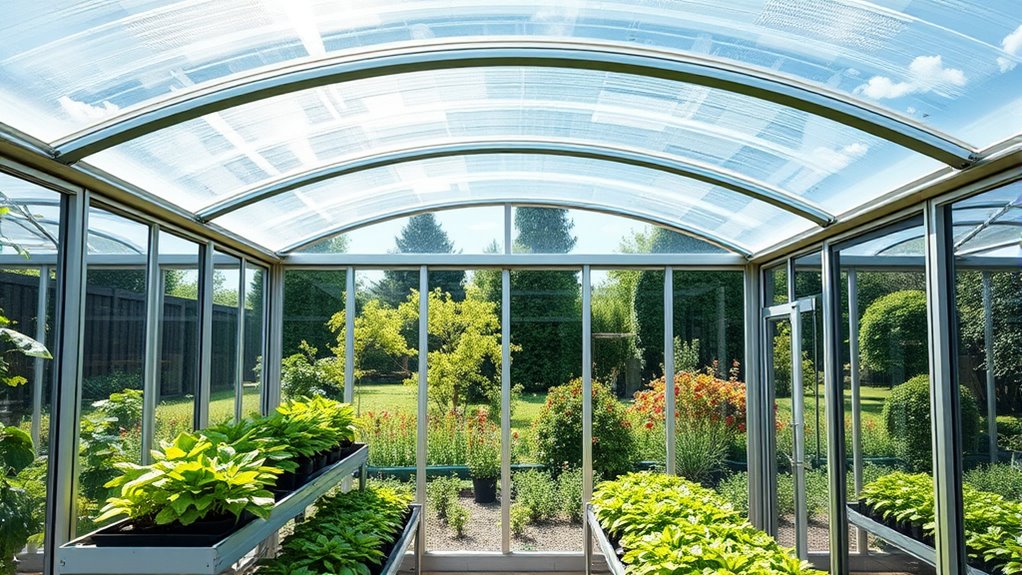
Polycarbonate greenhouses are a popular modern alternative to traditional glass structures, offering durability and excellent light transmission. They provide superior impact resistance, making them less prone to damage from hail, debris, or accidental impacts. This resilience guarantees your greenhouse remains intact over time, reducing maintenance costs. Additionally, polycarbonate panels come with built-in UV protection, shielding plants and interior components from harmful ultraviolet rays while still allowing ample sunlight to enter. The use of impact-resistant materials also contributes to enhanced environmental sustainability by reducing the need for repairs or replacements. Their lightweight construction also simplifies installation and handling. Furthermore, advancements in material technology have improved the clarity and thermal insulation properties of polycarbonate panels, making them even more effective for greenhouse use. The panels often feature UV protection that extends their lifespan and maintains their transparency over time. Incorporating energy-efficient features can further optimize temperature control and reduce heating and cooling costs in your greenhouse. A notable benefit is that the cost-effectiveness of polycarbonate panels makes them an attractive choice for both hobbyists and commercial growers.
PVC Frame Greenhouses

Are PVC frame greenhouses a practical choice for your gardening needs? They offer affordability and ease of assembly, making them popular among hobbyists. Here are four key benefits:
- PVC durability: The frames are sturdy and resistant to corrosion, ensuring long-lasting use. Additionally, understanding cybersecurity fundamentals can help protect your greenhouse setups from digital threats and unauthorized access.
- UV resistance: High-quality PVC resists sun damage, maintaining strength and appearance over time. This resilience is particularly important as climate conditions become more unpredictable, highlighting the importance of material resilience in greenhouse longevity.
- Lightweight design: Easy to move and modify, perfect for flexible gardening setups. Their flexibility allows gardeners to adapt their spaces easily to changing needs.
- Cost-effective: They’re generally cheaper than metal or wooden structures, ideal for budget-conscious gardeners. While not as robust as other materials, PVC frame greenhouses excel in low-maintenance, temporary, or beginner setups. They offer practical durability and UV resistance for growing plants efficiently, and understanding the cycle of breakups can help gardeners navigate setbacks with resilience and patience.
Tunnel and Hoop Greenhouses
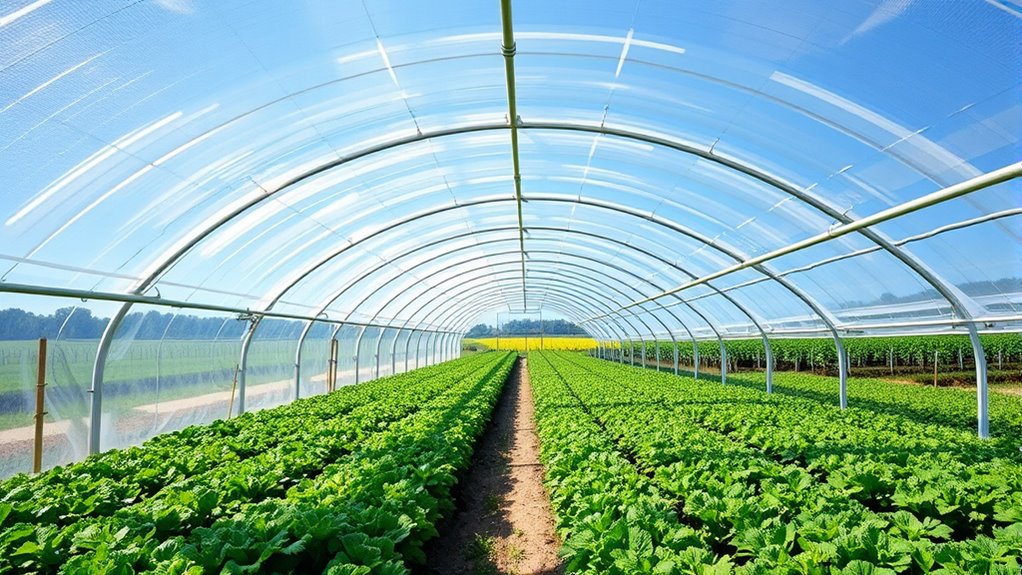
Tunnel and hoop greenhouses typically use lightweight materials like galvanized steel or plastic for their frames. They rely on simple ventilation and shading techniques to regulate temperature, making them suitable for various crops. You’ll find these structures ideal for quick-growing vegetables and seasonal plants. Additionally, some models can be upgraded with electric bike conversion kits to facilitate the transportation of harvested produce efficiently. Proper ventilation systems are essential to prevent overheating and maintain optimal growing conditions in these structures. These greenhouses are often praised for their cost-effectiveness and ease of setup, making them a popular choice among home gardeners and small-scale farmers. Moreover, selecting the right size restrictions and understanding local regulations can help ensure the proper placement and compliance of your greenhouse.
Construction Materials Used
Construction materials for tunnel and hoop greenhouses are selected for durability, cost-effectiveness, and light transmission. You’ll find options that support features like solar panel integration, giving your greenhouse energy independence.
Common materials include:
- Polyethylene film – lightweight, affordable, and excellent for light transmission.
- Polycarbonate panels – more durable, with better insulation, suitable for integrating solar panels.
- PVC or galvanized steel frames – strong and resistant, ideal for supporting automated ventilation systems.
- Wire or mesh coverings – offer ventilation and pest control while maintaining durability.
Choosing the right materials assure your greenhouse is sturdy and adaptable for technological upgrades, like automated ventilation systems, which optimize climate control and energy efficiency. Additionally, selecting materials with integration capabilities can enhance the overall performance and sustainability of your greenhouse setup, especially when considering meteorological advice for optimal operation.
A variety of construction options can be tailored to specific environmental conditions, ensuring your greenhouse remains resilient across different climates. Incorporating insulation properties into material choices can further improve temperature regulation and energy conservation.
Temperature Regulation Methods
To effectively regulate temperature in tunnel and hoop greenhouses, you need a combination of passive and active methods that maintain ideal growing conditions. Ventilation techniques like side vents, roof vents, and exhaust fans help remove excess heat and humidity. Heating systems such as portable heaters or ground heat can provide warmth during cold periods. Proper insulation also minimizes heat loss. Use the table below to explore key methods:
| Method | Description |
|---|---|
| Ventilation Techniques | Improve airflow, control humidity, and prevent overheating |
| Heating Systems | Maintain consistent temperatures during cold weather |
| Insulation | Reduce heat loss and conserve energy |
| Shade Structures | Protect plants from excessive heat during summer |
Ideal Crop Types
Are you wondering which crops thrive best in tunnel and hoop greenhouses? These structures are ideal for fast-growing, high-value plants. Consider these options:
- Leafy greens like lettuce and spinach grow quickly with hydroponic setups.
- Herbs such as basil, cilantro, and parsley flourish in controlled environments.
- Tomatoes and peppers benefit from the consistent warmth and space.
- Aquaponic systems work well for strawberries and certain strawberries varieties.
Tunnel and hoop greenhouses offer the flexibility to incorporate hydroponic setups or aquaponic systems, maximizing space and yield. Their design supports rapid crop turnover and year-round production, making them perfect for vegetable and herb growers seeking efficiency and high-quality harvests.
Portable and Pop-up Greenhouses
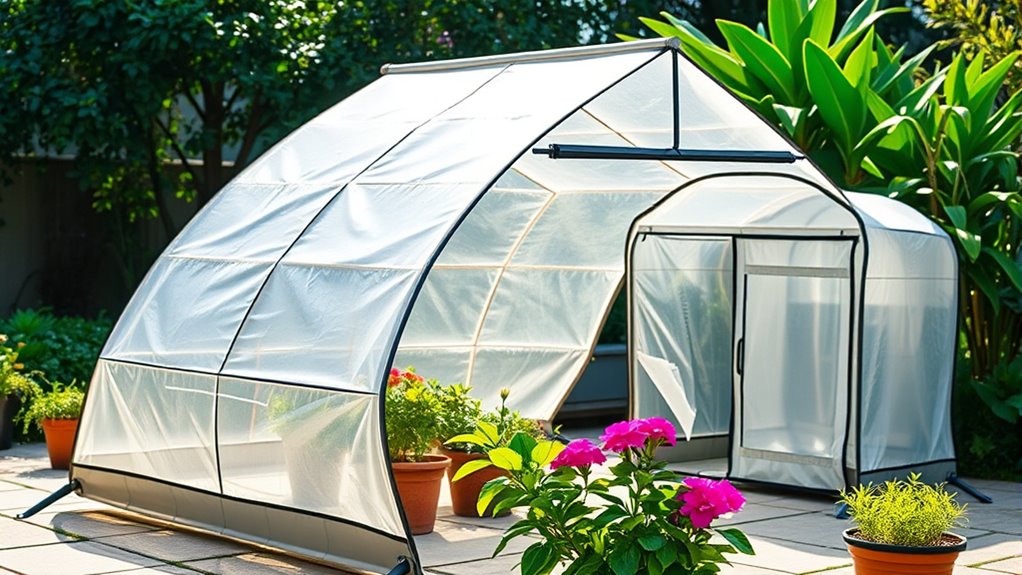
Portable and pop-up greenhouses are perfect if you want quick setup and easy mobility. They save space and can be stored away when not in use, making them ideal for small yards or patios.
Plus, they often come at a lower cost, helping you stay within your budget.
Easy Setup Process
Because they’re designed for quick and effortless setup, portable and pop-up greenhouses are ideal choices for gardeners who want to start growing without complicated installation. You can have your greenhouse up in minutes, making it perfect for beginners or those with limited space.
To guarantee a smooth setup, follow these tips:
- Read the manufacturer’s installation instructions carefully.
- Choose a flat, stable surface for placement.
- Secure the frame properly to prevent collapse.
- Regularly check for tears or damage to maintain its integrity.
These greenhouses typically require minimal maintenance, but you should occasionally clean the fabric and check for loose fittings. Their simplicity in setup and upkeep makes them a convenient option for quick gardening success.
Space-Saving Design
Space-saving design is a key advantage of portable and pop-up greenhouses, making them ideal for gardeners with limited space. These structures are easy to set up and move, allowing you to maximize small areas.
You can incorporate vertical gardening within these greenhouses, using walls and stands to grow more plants vertically, saving floor space. If you have a rooftop, a rooftop greenhouse offers a compact way to transform unused space into a thriving garden.
Portable greenhouses can be quickly assembled on decks or patios, offering a flexible solution for urban gardeners. Their collapsible nature means you can store them away when not in use.
Budget-Friendly Options
If you’re looking to start gardening without breaking the bank, budget-friendly portable and pop-up greenhouses are excellent options. These greenhouses are easy to set up and perfect for beginners or limited spaces.
Consider these options:
- DIY kits that let you assemble your greenhouse using simple tools and instructions.
- Recycled materials, like repurposed plastic or old windows, to build a cost-effective structure.
- Pop-up models made from lightweight fabrics or plastic that fold away when not in use.
- Portable designs with wheels or collapsible frames for quick relocation or storage.
These options help you save money while providing a functional environment for your plants. They’re ideal for those wanting an affordable, flexible greenhouse solution without sacrificing usability.
Lean-to Greenhouses
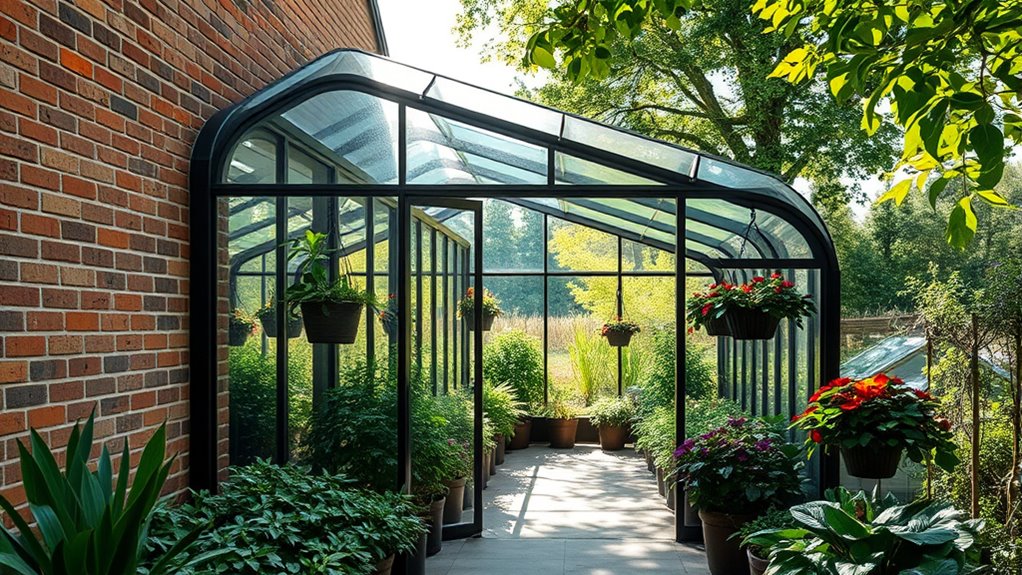
A lean-to greenhouse is a practical and efficient structure that attaches directly to the side of an existing building, such as a house or barn. This design maximizes spacial efficiency by sharing a wall, saving valuable space in your yard.
Its exterior integration allows the greenhouse to blend seamlessly with your current structure, giving it a sleek, unified look. Because it relies on an existing wall for support and partial insulation, it often costs less to build and maintain.
Lean-to greenhouses are ideal if you have limited space but want a functional area for growing plants. With proper placement, you benefit from natural sunlight and easy access, making your gardening experience more convenient and efficient.
Cold Frames and Mini Greenhouses

Cold frames and mini greenhouses offer compact, affordable solutions for extending your growing season and protecting young plants. They’re perfect for plant propagation, giving seedlings a warm environment to thrive. Plus, they help with pest control by creating a barrier against insects and animals. Here are some benefits:
- Easy to set up and move around
- Ideal for starting seeds early
- Enhance plant growth and health
- Protect plants from harsh weather
These small structures are great for hobby gardeners or limited spaces. They allow you to control temperature and humidity, making plant propagation more successful.
Their affordability and versatility make them an excellent choice for nurturing your plants and extending your gardening season efficiently.
A-Frame and Geodesic Greenhouses
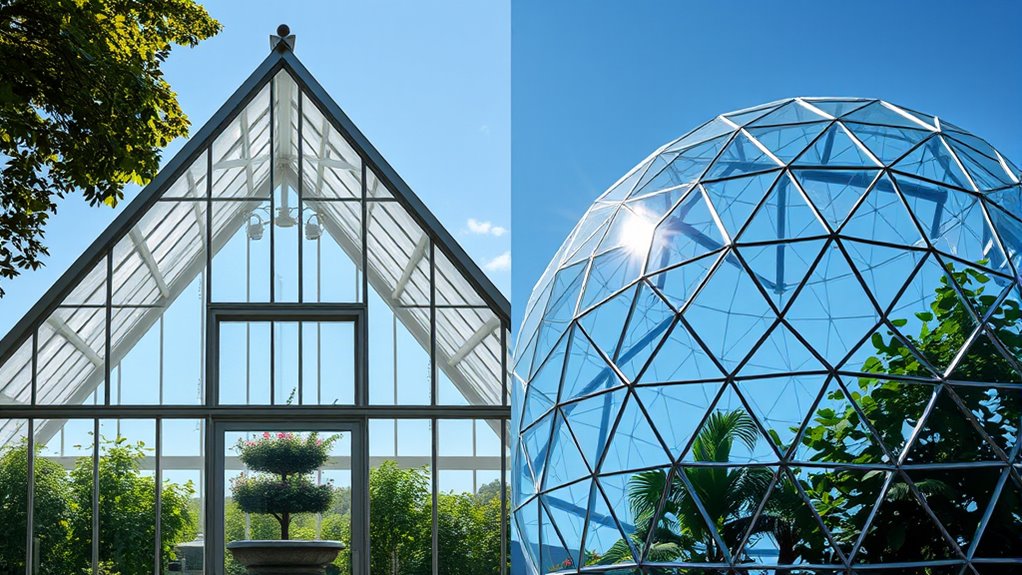
A-Frame and geodesic greenhouses offer innovative designs that maximize space and light efficiency. An A-frame design features a steeply pitched roof, creating a simple, sturdy structure that sheds snow and rain easily. This compact, space-efficient design makes it ideal for smaller gardens.
On the other hand, a geodesic structure uses a geodesic framework of triangles, providing exceptional strength and durability. Its unique shape distributes stress evenly, allowing for larger interior spaces with minimal material.
Both styles enhance natural light exposure and airflow, promoting healthy plant growth. The A-frame’s simplicity suits DIY enthusiasts, while the geodesic’s complex structure offers excellent stability for larger setups.
Choosing between them depends on your available space, budget, and gardening goals.
Frequently Asked Questions
Which Greenhouse Type Is Most Energy-Efficient for Winter Growing?
When considering winter growing, you want the most energy-efficient greenhouse. Look for one that utilizes solar heating and has excellent thermal insulation, helping retain heat naturally.
A greenhouse with double-glazed panels or insulated walls minimizes energy loss, reducing your heating costs. By maximizing solar gain and minimizing heat escape, you’ll create a warmer environment with less energy input, making your winter gardening more sustainable and cost-effective.
How Do Maintenance Costs Vary Among Different Greenhouse Materials?
Oh, the joys of maintenance costs—who knew that choosing the right greenhouse material could be so entertaining? You’ll find that a cost comparison reveals some surprises, with durable materials like polycarbonate or glass often requiring less upkeep over time.
Durability factors play a big role; sturdier options might cost more upfront but save you money on repairs and replacements, making your greenhouse both a smart and amusing investment.
Can Portable Greenhouses Be Customized for Specific Plant Needs?
You can definitely customize portable greenhouses for your plant needs. Portable customization allows you to adjust ventilation, shading, and temperature controls easily, ensuring your plants thrive.
What Is the Typical Lifespan of Each Greenhouse Type?
When considering greenhouse longevity, you focus on material durability to gauge how long each type lasts.
Generally, glass greenhouses offer the longest lifespan, often 20 years or more, thanks to their sturdy materials.
Plastic greenhouses tend to have shorter longevity, around 5-10 years, because plastics can degrade over time.
Metal structures are quite durable, lasting 15-20 years if maintained well.
Your choice depends on the durability you need for your gardening goals.
Which Greenhouse Options Are Best for Small Urban Spaces?
If you have limited space, consider a roof garden or vertical farming setup. Roof gardens make use of unused rooftop areas.
Vertical farming maximizes your space by growing crops upward. Both options are excellent for small urban environments, allowing you to cultivate plants efficiently without requiring large land areas.
These options are eco-friendly, space-saving, and perfect for urban dwellers who want to enjoy gardening or fresh produce at home.
Conclusion
Choosing the right greenhouse is like finding the perfect key to open your garden’s potential. Whether you prefer the classic charm of glass, the durability of polycarbonate, or the flexibility of portable options, each type offers its own unique benefits. Think about your space, budget, and plants’ needs. With the right match, your greenhouse will become a fertile ground for growth, turning your gardening dreams into a lush, vibrant reality.
